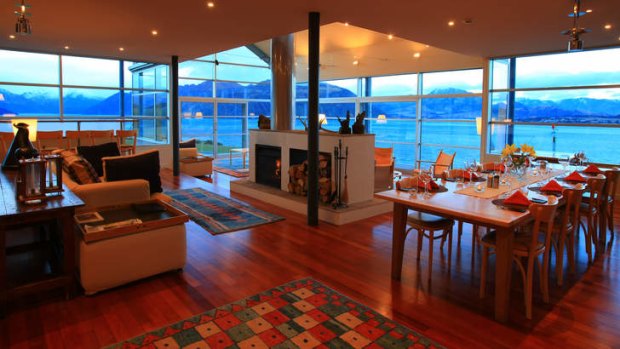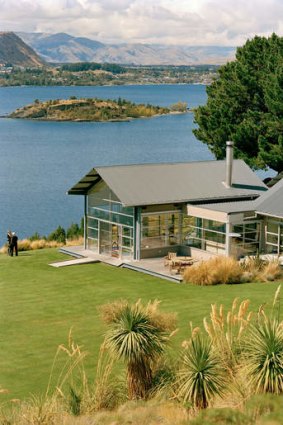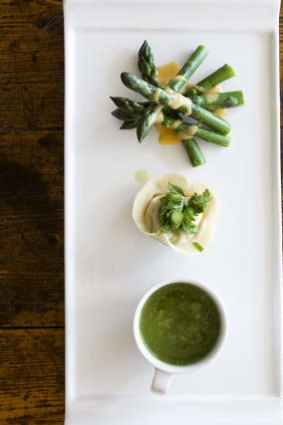
The lodge's welcoming lounge and dining area.
Anthony Dennis discovers the secrets behind New Zealand's tourism niche, envied as it is by their Australian counterparts, among others.
It's breakfast time at Whare Kea Lodge & Chalet. The morning sun is pouring in to the glass-encased open-plan living room from across the Harpic blue waters of Lake Wanaka and the still-snowy-in-spring Southern Alps that tower over it, illuminating the space with the intensity of a 7-Eleven by night. It's so bright that I feel like popping back to my bedroom to fetch my sunglasses.
But I remain seated, transfixed by the wraparound views, more or less mandatory at a salubrious New Zealand lodge such as this one. Just as my kindly middle-aged waitress places my caffe latte order on the dining table before me some of the contents spill into a saucer, forming a little brown moat around the bottom of the glass. She insists on replacing it but I demur. "But it won't be perfect," she says.

Dramatic: the view from Whare Kea.Credit: Alamy
Ah, New Zealand luxury lodges: perfect one day, near perfect the next. Perfection, if you can afford it, what with the heady nightly rates asked for this level of accommodation, is at the essence of the Kiwi concept of a luxury lodge, and faux pas usually don't get more trifling than the above. Indeed, I've long admired what the New Zealanders have achieved with their lodges in a relatively short time.
The first luxury lodge, Huka, opened in the 1920s but most of the others, including Whare Kea, have been established only in the past few decades or so. Compare that with Japan's ryokans or Spain's paradores, whose origins stretch back centuries, and you realise how much those canny Kiwis have achieved. While New Zealand, due to its size, has relatively few true five-star hotels, its network of luxury lodges now extends from the top of the North Island to the bottom of the South Island.
They offer a model an envious Australian tourism industry has only most recently managed to emulate in the form of the internationally lauded Kangaroo Island's Southern Ocean Lodge and Tasmania's Saffire Freycinet. Certainly, the widespread international recognition of New Zealand's lodges (though few, if any, to my knowledge, are run at a profit) has long been the subject of near 100 per cent irritation from their Australian tourism counterparts.

Asparagus tasting plate.
It's been akin to the hospitality equivalent of the All Blacks' dominance of the Wallabies in rugby union: you win some, you lose many. I know one shrewd Australian operator, determined to replicate the Kiwi lodge model on his own terms, who spent a fortnight travelling around New Zealand taking notes. He went on to open an award-winning, all-Australian lodge, with more belatedly following. So just what is it about the Kiwis that allowed them to create such unique places, attracting wealthy guests from Europe, North America, and more lately Australia?
Somehow the more reserved national demeanour of the New Zealander seems to make him or her better suited to service at this level of travel than Australians, especially when you consider the fact that tourism is one of the two most important earners of foreign exchange for the Kiwi economy. They manage to be friendly yet not excessively familiar.
Whare Kea, which I visited not long ago, is, typical of a New Zealand lodge - dramatically located. It's perched on a hillside about 50 metres above the wondrous, 42-kilometre-long Lake Wanaka, just outside the inoffensive eponymous resort town, about an hour's scenic drive across the Crown Range from Queenstown. The starkly simple, homestead-like main lodge building also boasts the Southern Alps - the highest mountain range in Australasia with 16 peaks above 3000 metres - as its backdrop visible from every suite. Each of the just six rooms afford lake and mountain views beyond an extended lawn (perfect for dramatic and convenient chopper landings for aerial tours of the mountains) and feature walk-in wardrobes, writing desks, Bose sound systems and complimentary Wi-Fi. Frankly, I've slept in more luxurious suites than my one at Whare Kea, but that's not the point. If anything, your room at the New Zealand luxury lodge is a minor protagonist in the story of your stay.
Guests at Whare Kea Lodge & Chalet enjoy the privilege of being able to sample the award-winning cooking of talented British-born chef James Stapley, as well as New Zealand's finest wines. Exceptional cuisine, and lots of it, along with the finest wines, is one of the formulas behind the success of the New Zealand lodge model, with Stapley's contemporary Kiwi cuisine by far the best I've eaten at any of these exclusive properties.
"When we first visited the area of Wanaka we both fell in love with it," co-owner Louise Myer says. "The sheer beauty of the Southern Alps, the area's lakes and farmlands held real wow factor for us. We knew immediately that this would be a fabulous place to holiday, not only for the beauty of the landscape, but [also] for the wealth of activities this mountain paradise provides." Whare Kea's owners, Louise and Martyn Myer, of the famed Melbourne retailing and philanthropic family, are - ironically, considering all that envy across the ditch - Australians, with most of the other major lodges around New Zealand owned by Americans, Dutch and just one Kiwi.
Earlier this year Louise Myer was named "Woman of the Year", for what it's worth, by Relais & Chateaux, the prestigious accommodation group of which Whare Kea is a member.
The Myers designed the Japanese-influenced main building to complement the surrounding dramatic environment. Whare Kea's lodge, inspired by local farm buildings, was designed by Louise's husband Martyn and the late Melbourne architect John Mayne, a business partner of ex-Victorian Premier Ted Baillieu. Inside, Christopher Hansson of the Melbourne-based architectural and design firm Inarc employed a colour scheme inspired by nature and the surrounding lake and mountains complemented by Nordic-style furniture and artwork by local artists.
The Myers then upped the ante on all other New Zealand lodges by building a chalet, which doubles as a weather station accessible only by helicopter (used like buses around here) from a Southern Alps mountain top about 20 minutes' flying time from the main lodge beside Lake Wanaka.
The fully equipped chalet delivers complete privacy and seclusion. Even in late spring, when I fly over it in a chopper, it remains a black speck in a sea of deep snow. In recent years the Myers have opened the doors of the chalet to artists for sabbaticals where they can indulge their creativity in exceptional surroundings.
"In comparison to a hotel, an experience at a [New Zealand] lodge is all encompassing," Louise Myer says.
"We not only provide you with an elegant and comfortable room, but [also] organise for all your needs whether visiting local galleries and exploring neighbouring vineyards, to planning a whole program of diversions from skiing and hiking to cycling and flight-seeing tours."
Myer believes that in terms of tourism, Australians need to be more passionate about their country and what it has to offer. They must commit to working harder at training staff to deliver a higher quality of service, with attention to detail as an imperative.
After a few blissful yet busy days at Whare Kea, buzzing over the Southern Alps by chopper and even a Tiger Moth, and exploring Lake Wanaka and islands by boat and on foot, I reckon that I can overlook that minor coffee mishap. No use crying over spilt latte.
The writer was a guest of Whare Kea Lodge & Chalet and Air New Zealand.
TRIP NOTES
MORE INFORMATION
GETTING THERE
Air New Zealand (airnewzealand.com.au) operates flights from Sydney and Melbourne to Queenstown via Christchurch, Wellington and Auckland. Wanaka is about an hour's drive from Queenstown's international airport. Whare Kea Lodge can arrange transfers for guests who don't have their own vehicles.
STAYING THERE
Nightly rates a person start at $NZ500 ($440) plus 15 per cent GST. Includes pre-dinner drinks, canapes, dinner and breakfast. See wharekealodge.com.
FIVE OTHER GREAT KIWI LODGES
HAPUKU LODGE, KAIKOURA
There's no better place to crash after a day out in the whale-watching capital of New Zealand than in one of these snug, architect-designed tree houses with the Pacific Ocean and the usually snow-capped Southern Alps as a backdrop. Phone +64 (03) 319 6559; see hapukulodge.com.
BLANKET BAY LODGE, GLENORCHY
This quintessential, rustic NZ lodge, owned by an heir to the Levi Strauss fortune, is about an hour's drive from Queenstown and close to the sublime alpine locations used in Peter Jackson's Lord of the Rings trilogy. Phone +64 3 441 0115; see blanketbay.com.
FIORDLAND LODGE, TE ANAU
A perfect base for both Milford and Doubtful sounds, this lodge, with surprisingly small rooms, features a towering, chapel-like main lounge that's ideal for lingering in on cold winter days with a book and a glass of local pinot noir. Phone +64 3 249 7832; see fiordlandlodge.co.nz.
MATAKAURI LODGE, QUEENSTOWN
The latest property from the New York-based Robertson family, the intimate Matakauri Lodge is just a short drive from Queenstown but enjoys a secluded lakeside and forest location with views of The Remarkables mountain range. Phone +64 3 441 1008; see matakauri.co.nz.
TREETOPS LODGE, ROTORUA
Built over three decades in the heart of the North Island's "forest and thermal wonderland", this NZ-owned lodge is, as the name suggests, nestled in a native "eco-park", with a focus on activities such as hunting and trout fishing. Phone +64 7 333 2066; see treetops.co.nz.
Sign up for the Traveller Deals newsletter
Get exclusive travel deals delivered straight to your inbox. Sign up now.